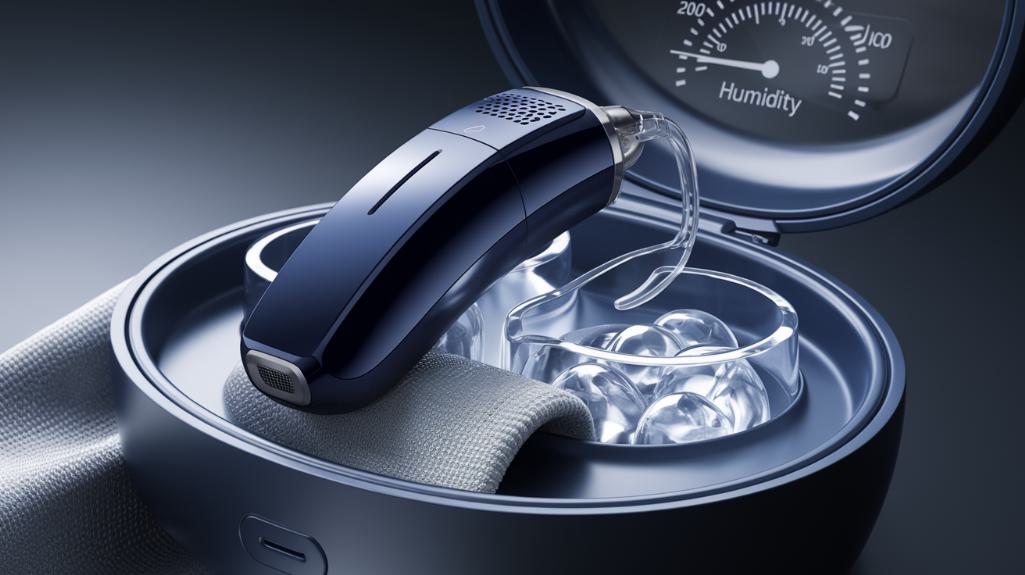
Hearing Aid Maintenance : The Complete Guide 2025
Proper hearing aid maintenance combines daily care with long-term strategies to safeguard your investment. You'll need to wipe your devices daily, clean microphone ports regularly, and manage moisture with a dehumidifier case overnight. Essential tools include wax picks, brushes, and sanitizing wipes, while professional checkups every 4-6 months guarantee superior performance. By following these basics, you're just scratching the surface of thorough hearing aid care.
In a hurry? Here's a brief summary.
- Clean hearing aids daily with a soft cloth and specialized tools to remove debris, earwax, and maintain optimal performance.
- Store devices in a dehumidifier case overnight and use moisture-absorbing solutions to prevent water damage.
- Establish a consistent charging routine and maintain backup batteries while keeping the charging dock clean and properly positioned.
- Schedule professional checkups every 4-6 months for deep cleaning, diagnostics, and necessary programming adjustments.
- Protect hearing aids from environmental hazards like heat, moisture, and direct sunlight while planning for eventual replacement after 3-7 years.
Daily Cleaning Essentials and Best Practices
A well-maintained hearing aid becomes your trusted companion in steering life's precious soundscapes. You'll want to make cleaning your device a daily ritual, just like brushing your teeth, to guarantee top-notch performance and longevity.
Start by gently wiping your hearing aid with a soft, dry cloth each evening, removing any moisture or debris that's accumulated throughout the day. Don't forget to check the microphone ports and receiver openings - they're like tiny doorways for sound that need to stay clear. Using your cleaning brush, sweep away any earwax buildup, and remember to replace wax guards monthly. When you're not wearing your device, store it in a dehumidifier case overnight - it's like treating your hearing aid to an invigorating spa session while you sleep.
Tools and Products for Proper Maintenance
Proper maintenance starts with having the right tools at your fingertips - think of it as assembling your hearing aid care toolkit! You'll want to gather these essential items to keep your devices performing their best.
| Tool Type | Purpose |
|---|---|
| Cleaning Tools | Wax pick, brush, and wire loop |
| Drying Solutions | Dehumidifier and drying container |
| Care Products | Sanitizing wipes and battery tester |
Don't forget to store these tools in a dedicated case - you're going to love how organized you'll feel! While it might seem like a lot to collect at first, you'll quickly discover that having the right tools makes maintenance a breeze. Remember, investing in quality maintenance tools now will save you money on repairs later, and you'll feel confident knowing you're protecting your valuable hearing aids.
Moisture Management and Storage Solutions
Protecting your hearing aids from moisture starts with understanding that these tiny devices face big challenges from humidity, sweat, and environmental conditions every day.
Moisture is a constant battle for hearing aid users, with daily exposure to humidity, perspiration, and weather putting these delicate devices at risk.
You'll want to invest in a quality dehumidifier case, which works overnight to remove trapped moisture while you're sleeping.
Don't let the morning dew catch you off guard - keep silica gel desiccants handy in your storage case to absorb excess moisture. After a workout or on rainy days, you'll find that a UV-C sanitizing unit isn't just for killing bacteria - it's fantastic for drying out your devices too.
Store your hearing aids in a cool, dry place, and you'll be amazed at how a simple protective case with a moisture-absorbing lining can extend their life and maintain top-notch performance.
Battery Care and Charging Guidelines
Keeping your hearing aids powered properly isn't just about having fresh batteries - it's about knowing how to store, charge, and replace them at the right time. You'll want to develop a consistent charging routine, whether you're using rechargeable hearing aids that need nightly charging or disposable batteries that typically last 3-10 days.
For the best performance and longest battery life, store your spare batteries at room temperature, away from metal objects and moisture, and always keep a backup set handy for those moments when you need them most.
Hearing Aid Battery Life Calculator
Charging Best Practices
The longevity of your hearing aid's power system depends heavily on following smart charging practices and battery care routines. You'll get the best results by charging your device at the same time each day, preferably overnight when you're not using it. Don't wait until your hearing aid is completely drained - it's better to maintain a consistent charging schedule.
Make sure you're using the original charging dock in a clean, dry location away from direct sunlight and heat sources. While it might be tempting to use that spare phone charger, stick with the manufacturer's equipment to protect your investment. Keep the charging contacts clean with a soft, dry cloth, and don't forget to give your charging case a weekly wipe-down too - those tiny dust bunnies can really interfere with proper charging.
Battery Storage and Replacement
Proper storage and regular replacement of your hearing aid batteries can make a world of difference in your device's performance and reliability. You'll want to establish a consistent routine for checking and maintaining your batteries to certify you're never caught off guard with a dead device at an important moment.
The guidelines for proper maintenance include:
- Store unused batteries at room temperature, never in the refrigerator or hot places.
- Keep batteries in their original packaging until you're ready to use them.
- Remove batteries if you won't be using your hearing aids for several days.
- Clean the battery compartment regularly with a dry cloth.
- Mark your calendar when you install new batteries to track their lifespan.
Professional Service Schedules and Checkups
You'll want to book professional checkups for your hearing aids every 4-6 months, just as you'd schedule regular maintenance for your car.
During these crucial appointments, your audiologist will perform a thorough deep cleaning, run diagnostic tests, and make any necessary adjustments to guarantee superior performance. These professional services aren't just routine maintenance - they're your best defense against costly repairs and your ticket to consistently clear, reliable hearing that you can count on every day.
Regular Maintenance Intervals
Maintaining a consistent schedule of professional checkups will keep your hearing aids performing at their absolute best. You'll want to mark your calendar for these essential maintenance milestones to guarantee superior performance and longevity.
Here's your ideal maintenance schedule to keep your devices in top shape:
- Monthly deep cleaning and battery compartment inspection
- Quarterly professional cleaning and performance testing
- Semi-annual programming adjustments and hearing evaluation
- Annual detailed device assessment and warranty review
- Bi-annual moisture check and wax guard replacement
Don't wait until you notice problems—staying ahead of potential issues will save you time and money. Remember, you've invested in better hearing, so protecting that investment through regular maintenance isn't just smart—it's essential for your continued hearing success.
Deep Cleaning and Repairs
Professional hearing aid servicing brings specialized expertise and advanced cleaning techniques that go far beyond basic at-home care. You'll want to schedule thorough cleanings every 4-6 months, where trained technicians can access those hard-to-reach components with ultrasonic cleaners and specialized tools.
During these visits, you're not just getting a deeper clean—you're investing in your hearing aid's longevity. The technician will check for wear patterns, test the electronics, and replace any worn-out parts before they cause problems. Don't wait until your device starts acting up; regular professional servicing can catch potential issues early, saving you time and money in the long run. Plus, you'll leave with that satisfying feeling of knowing your hearing aids are performing at their absolute best.
Hearing Aid Maintenance Schedule Generator
Common Problems and Quick Fixes
Despite proper care, hearing aids can occasionally present frustrating challenges that need quick solutions. Don't worry - you'll find that most common issues have simple fixes you can handle right at home!
Most hearing aid problems have straightforward solutions you can manage yourself, so don't let minor issues discourage you.
If you're hearing whistling sounds (feedback), try adjusting the fit or removing any earwax buildup.
When your device sounds weak, replace the battery or clean the microphone openings.
If there's no sound at all, check if the battery's inserted correctly and the volume's turned up.
For intermittent sound, inspect for moisture and use a dehumidifier overnight.
When sound quality seems distorted, examine the tubing for cracks or debris.
Hearing Aid Troubleshooting Wizard
Select the symptoms you are experiencing:
Advanced Cleaning Techniques for Different Hearing Aid Styles
Now that you've mastered the basics of troubleshooting, let's explore the specialized cleaning methods that'll keep your specific type of hearing aid performing at its best!
For behind-the-ear (BTE) models, you'll want to focus on the tube and earmold, gently using your cleaning wire to remove any stubborn debris while holding the parts downward.
In-the-ear (ITE) aids require extra attention to their tiny sound ports and vents - your cleaning brush will become your best friend here!
For completely-in-canal (CIC) devices, you'll need to be particularly gentle with the removal string and battery compartment, using a soft, dry cloth to wipe away earwax buildup. Remember, your cleaning kit's wax pick is perfect for those hard-to-reach spaces, but don't get too enthusiastic - a light touch works wonders
Protecting Your Device From Environmental Damage
Taking care of your hearing aid means defending it against the elements that threaten its performance every day. You'll need to protect your valuable device from moisture, heat, dust, and physical damage to guarantee it keeps working perfectly.
Store it in a dehumidifier case overnight to remove trapped moisture. Keep it away from direct sunlight and heat sources, which can damage internal components. Use a protective sleeve when you're outdoors in dusty or windy conditions. Remove your hearing aid before swimming, showering, or using hair products. Carry a small protective case for safe storage when you're not using it.
Long-Term Care Strategies and Replacement Planning
While daily protection keeps your hearing aid functioning well, long-term care planning guarantees you'll never miss a beat in your hearing journey. You'll want to schedule professional cleanings every six months, and don't forget to mark your calendar for annual hearing evaluations to confirm that your device still matches your needs.
Most hearing aids last between 3-7 years, so start saving for a replacement well in advance. You can extend your device's lifespan by keeping detailed maintenance records, tracking performance changes, and responding quickly to any issues. Consider investing in an extended warranty or insurance plan - it's like a safety net for your hearing investment. Remember to stay informed about technological advances, as newer models might offer features that could substantially enhance your hearing experience.
Conclusion
Taking proper care of your hearing aids isn't just about maintaining expensive devices - it's about preserving your connection to the world around you. By following these maintenance guidelines, you'll extend your hearing aids' lifespan, guarantee top-notch performance, and save money in the long run. Remember, you're not just cleaning a device; you're investing in your quality of life, so make these care routines part of your daily habits
